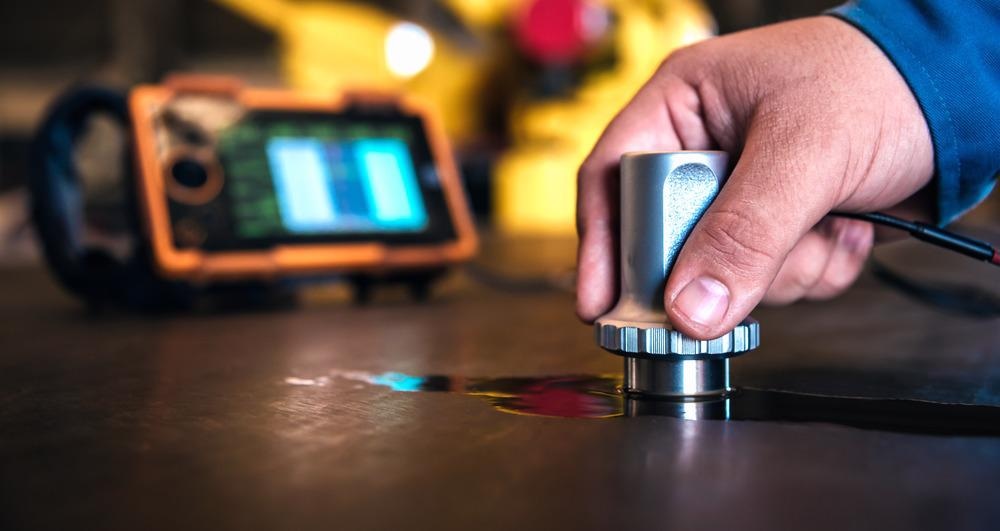Article updated on 26 August 2021

Image Credit: N_Sakarin/Shutterstock.com
Everything has a quality control process to ensure its safety and integrity. Everyday items and large infrastructure are continually subjected to wear and tear, causing damage and erosion, while the weather can cause rusting and corrosion. Testing materials for defects and flaws is incredibly important; the consequences of faults in some materials or structures could be catastrophic. There are various different tests a material might undergo, some are destructive and involve damaging a prototype running shoe for example, while others are non-destructive and can be used to guarantee the integrity of infrastructure before and during its useful lifetime.
What is Non-Destructive Testing?
Non-destructive testing (NTD) combines physics, maths, biology, and chemistry to create ways of testing materials that leave them completely undamaged. Testing can be done throughout the manufacturing or construction process before the object is fully formed, or during use. This means the structure – train tracks for example – can continue to operate with little-to-no interruption.
NDT is a crucial part of quality control and is necessary wherever there is the need to be sure of the safety and stability of infrastructures, such as aircraft or bridges. It evaluates the properties of a material or structure to ensure components are manufactured to the correct standards and specifications.
It can also be used to ensure the continuing quality of components and in maintenance, ensuring there are no cracks in the aircraft wing, or the bridge is not too rusted and corroded, for example. NDT helps monitor the integrity of a structure throughout its lifecycle without affecting normal operations. It is used across a wide range of industries, including aerospace, power generation, oil and gas, nuclear, medical, rail, and in general manufacturing.
A Multitude of Tests
NDT can locate faults and imperfections on the surface and subsurface of materials. Different tests can analyze the different components of a structure and can be applied at any stage of manufacturing and construction. Ultimately, any materials or products failing the tests because of a flaw or defect needs to be repaired or replaced to ensure their continuing safety and integrity.
The most common NDT is a simple visual inspection. Either with or without the use of optical instruments such as magnifying glasses, this technique can detect corrosion, misalignment, and damages or cracks. Vibrational analysis is also quite common and uses sensors to measure the vibrational signatures from rotating machinery to assess its condition.
Other selected NDT methods include:
- Acoustic emission testing, which relies on detecting short bursts of ultrasound emitted by active cracks under a load. It is used during proof tests of pressure vessels, and bridges.
- Laser method testing, which is subdivided into holographic testing, laser profilometry, and laser shearography. Broadly speaking, the techniques use lasers to detect changes in surfaces under stress from heat or pressure for example.
- Magnetic flux leakage employs a powerful magnet to create a magnetic field that can saturate a steel structure; any changes in magnetic flux density resulting from pitting, erosion or corrosion is detected by a sensor.
- Thermal or infrared testing assesses the condition of a material using a sensor that determines the wavelength of IR light emitted from a surface.
- Ultrasonic testing uses high-frequency sound to provide clues to the condition of the material and is subdivided into pulse-echo inspection through transmission testing and time of flight diffraction.
Conclusion
NDT is an incredibly useful quality assurance management tool necessary for ensuring the integrity and safety of everyday objects and the larger infrastructure around us. Its ability to test materials and structures for flaws or defects without altering or destroying the original means the properties of a material or structure can be analyzed effectively, but without affecting normal operations.
References and Further Reading
TWI, What is Non-destructive Testing (NDT); Methods and Definition, TWI: https://www.twi-global.com/technical-knowledge/faqs/what-is-non-destructive-testing. Accessed 13 May 2021.
BINTD, The Importance of NDT and CM, BINTD: https://www.bindt.org/careers/careers-information/The-importance-of-NDT-and-CM/. Accessed 13 May 2021.
World Spec, What is NDT and it's benefits? World Spec: https://www.worldspec.org/. Accessed 13 May 2021.
Disclaimer: The views expressed here are those of the author expressed in their private capacity and do not necessarily represent the views of AZoM.com Limited T/A AZoNetwork the owner and operator of this website. This disclaimer forms part of the Terms and conditions of use of this website.